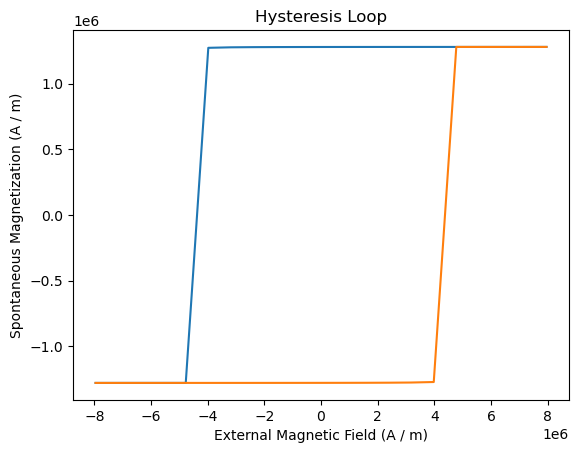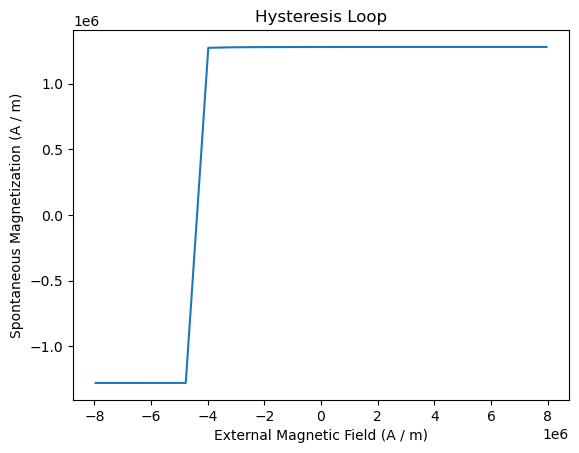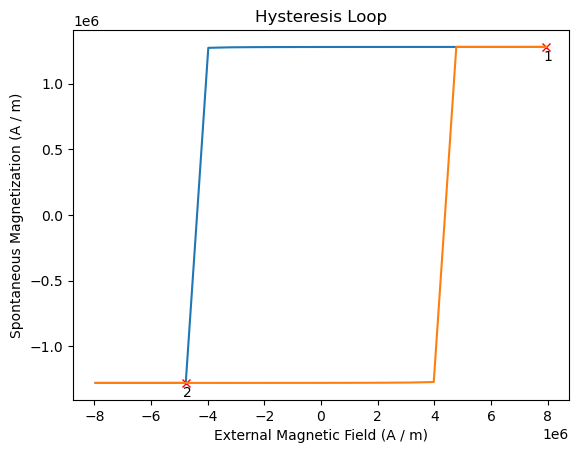mammos_mumag quickstart#
mammos_mumag can compute hysteresis loops of magnetic materials using finite elements.
Requirements:
mammosandesys-escript
import mammos_entity as me
import mammos_units as u
import pandas as pd
from mammos_mumag import hysteresis
u.set_enabled_equivalencies(u.magnetic_flux_field())
<astropy.units.core._UnitContext at 0x7f9b33f16dd0>
Hysteresis simulation#
The hysteresis.run function computes a hysteresis loop for a homogeneous material with given parameters. We need to pass in a suitable mesh, mammos_mumag.mesh provides a sample mesh.
hysteresis_result = hysteresis.run(
mesh="cube20_singlegrain_msize2",
Ms=me.Ms(1280000, unit="A/m"),
A=me.A(7.7e-12, unit="J/m"),
K1=me.Ku(4300000, unit="J/m3"),
theta=0,
phi=0,
h_start=(10 * u.T).to("A/m"),
h_final=(-10 * u.T).to("A/m"),
h_n_steps=20,
)
Hysteresis result object#
The returned results_hysteresis object provides a plot method to visualize the computed data. mammos_mumag.hysteresis only computes half a hysteresis loop, going from hstart to hfinal. To show a full loop this function mirrors the computed data and plots it twice:
hysteresis_result.plot();

To only see the actual simulation, we can use the flag duplicate=False:
hysteresis_result.plot(duplicate=False);

The results object provides access to:
the external field
Hthe magnetization
Min the direction of the applied fieldthe component
Mx,My,Mzof the spontaneous magnetizationthe energy density
hysteresis_result.H
[ 7957747.15026276 7161972.43523649 6366197.72021021 5570423.00518393
4774648.29015766 3978873.57513138 3183098.86010511 2387324.14507883
1591549.43005255 795774.71502628 0. -795774.71502628
-1591549.43005255 -2387324.14507883 -3183098.86010511 -3978873.57513138
-4774648.29015766 -5570423.00518393 -6366197.72021021 -7161972.43523649
-7957747.15026276],
unit=A / m)
hysteresis_result.M
[ 1279889.28858392 1279875.35487467 1279858.60865277 1279838.23693916
1279813.10960708 1279781.61816143 1279741.40923658 1279688.9282623
1279618.59692456 1279521.24777537 1279380.92895796 1279167.79124963
1278820.31896709 1278193.40901814 1276865.45558215 1273023.46966246
-1279813.11387701 -1279838.23510354 -1279858.60560256 -1279875.35242235
-1279889.28868812],
unit=A / m)
hysteresis_result.Mx
[ 1.33369419e+04 1.27642912e+04 1.21138305e+04 1.13685440e+04
1.05060693e+04 9.49642262e+03 8.29840374e+03 6.85388865e+03
5.07807497e+03 2.84220258e+03 -5.92135651e+01 -3.97555587e+03
-9.55402102e+03 -1.81446442e+04 -3.31351859e+04 -6.65045268e+04
-1.05064987e+04 -1.13683458e+04 -1.21134459e+04 -1.27639874e+04
-1.33368784e+04],
unit=A / m)
hysteresis_result.My
[ -48.88653309 -51.96927457 -55.4673908 -59.47103443 -64.09846682
-69.5089531 -75.91814415 -83.63248719 -93.09714579 -104.98673227
-120.37569967 -141.08903498 -170.50557468 -215.70060297 -294.72360668
-476.0020296 64.14680914 59.35556978 55.25696228 51.80783763
48.92009087],
unit=A / m)
hysteresis_result.Mz
[ 1279851.43397906 1279847.49250133 1279842.09608478 1279834.72859929
1279824.6500327 1279810.77494583 1279791.46867247 1279764.19052806
1279724.84138717 1279666.49962956 1279576.79725706 1279431.97819965
1279181.81279555 1278704.73773844 1277638.20888423 1274378.02605554
-1279824.64680899 -1279834.73022376 -1279842.09974628 -1279847.4953512
-1279851.43519197],
unit=A / m)
hysteresis_result.energy_density
[-16793259.14717998 -15513376.61777121 -14233509.37078527
-12953660.60369528 -11673834.47507029 -10394036.49593287
-9114274.12985359 -7834557.74471192 -6554902.1835602
-5275329.48376666 -3995873.86584996 -2716591.57883736
-1437582.25793929 -159041.64107598 1118580.91577263
2393925.95515716 -11673834.47506085 -12953660.60369348
-14233509.37077219 -15513376.61776414 -16793259.14717655],
unit=J / m3)
The attribute configuration_type contains a list of indices that refer to saved magnetization field configurations. We will use this information later.
hysteresis_result.configuration_type
array([1, 1, 1, 1, 1, 1, 1, 1, 1, 1, 1, 1, 1, 1, 1, 1, 2, 2, 2, 2, 2])
We can also get the hysteresis data as a pandas dataframe in SI units:
hysteresis_result.dataframe
| configuration_type | H | M | Mx | My | Mz | energy_density | |
|---|---|---|---|---|---|---|---|
| 0 | 1 | 7.957747e+06 | 1.279889e+06 | 13336.941917 | -48.886533 | 1.279851e+06 | -1.679326e+07 |
| 1 | 1 | 7.161972e+06 | 1.279875e+06 | 12764.291238 | -51.969275 | 1.279847e+06 | -1.551338e+07 |
| 2 | 1 | 6.366198e+06 | 1.279859e+06 | 12113.830536 | -55.467391 | 1.279842e+06 | -1.423351e+07 |
| 3 | 1 | 5.570423e+06 | 1.279838e+06 | 11368.544042 | -59.471034 | 1.279835e+06 | -1.295366e+07 |
| 4 | 1 | 4.774648e+06 | 1.279813e+06 | 10506.069334 | -64.098467 | 1.279825e+06 | -1.167383e+07 |
| 5 | 1 | 3.978874e+06 | 1.279782e+06 | 9496.422618 | -69.508953 | 1.279811e+06 | -1.039404e+07 |
| 6 | 1 | 3.183099e+06 | 1.279741e+06 | 8298.403739 | -75.918144 | 1.279791e+06 | -9.114274e+06 |
| 7 | 1 | 2.387324e+06 | 1.279689e+06 | 6853.888646 | -83.632487 | 1.279764e+06 | -7.834558e+06 |
| 8 | 1 | 1.591549e+06 | 1.279619e+06 | 5078.074971 | -93.097146 | 1.279725e+06 | -6.554902e+06 |
| 9 | 1 | 7.957747e+05 | 1.279521e+06 | 2842.202583 | -104.986732 | 1.279666e+06 | -5.275329e+06 |
| 10 | 1 | 0.000000e+00 | 1.279381e+06 | -59.213565 | -120.375700 | 1.279577e+06 | -3.995874e+06 |
| 11 | 1 | -7.957747e+05 | 1.279168e+06 | -3975.555866 | -141.089035 | 1.279432e+06 | -2.716592e+06 |
| 12 | 1 | -1.591549e+06 | 1.278820e+06 | -9554.021016 | -170.505575 | 1.279182e+06 | -1.437582e+06 |
| 13 | 1 | -2.387324e+06 | 1.278193e+06 | -18144.644173 | -215.700603 | 1.278705e+06 | -1.590416e+05 |
| 14 | 1 | -3.183099e+06 | 1.276865e+06 | -33135.185913 | -294.723607 | 1.277638e+06 | 1.118581e+06 |
| 15 | 1 | -3.978874e+06 | 1.273023e+06 | -66504.526815 | -476.002030 | 1.274378e+06 | 2.393926e+06 |
| 16 | 2 | -4.774648e+06 | -1.279813e+06 | -10506.498737 | 64.146809 | -1.279825e+06 | -1.167383e+07 |
| 17 | 2 | -5.570423e+06 | -1.279838e+06 | -11368.345772 | 59.355570 | -1.279835e+06 | -1.295366e+07 |
| 18 | 2 | -6.366198e+06 | -1.279859e+06 | -12113.445946 | 55.256962 | -1.279842e+06 | -1.423351e+07 |
| 19 | 2 | -7.161972e+06 | -1.279875e+06 | -12763.987414 | 51.807838 | -1.279847e+06 | -1.551338e+07 |
| 20 | 2 | -7.957747e+06 | -1.279889e+06 | -13336.878392 | 48.920091 | -1.279851e+06 | -1.679326e+07 |
We can generate a table in alternate units:
df = pd.DataFrame(
{
"mu0_H": hysteresis_result.H.q.to(u.T),
"J": hysteresis_result.M.q.to(u.T),
},
)
df.head()
| mu0_H | J | |
|---|---|---|
| 0 | 10.0 | 1.608356 |
| 1 | 9.0 | 1.608339 |
| 2 | 8.0 | 1.608318 |
| 3 | 7.0 | 1.608292 |
| 4 | 6.0 | 1.608261 |
Visualizing magnetization configurations#
To plot the hysteresis loop (including the available configurations), run
hysteresis_result.plot(configuration_marks=True);

We can get the location of the saved configurations from the attribute configurations:
hysteresis_result.configurations
{1: PosixPath('/home/petrocch/repo/mammos/mammos-mumag/examples/hystloop/hystloop_0001.vtu'),
2: PosixPath('/home/petrocch/repo/mammos/mammos-mumag/examples/hystloop/hystloop_0002.vtu')}
To inspect the configurations more conveniently directly in the notebook we can use the plot_configuration function of hysteresis_result. We need to pass the index and get an interactive 3D plot (using pyvista):
hysteresis_result.plot_configuration(1)
JS Error => TypeError: `target` argument of Proxy must be an object, got null
Note: the small object size is a consequence of the empty sphere around the cube.
